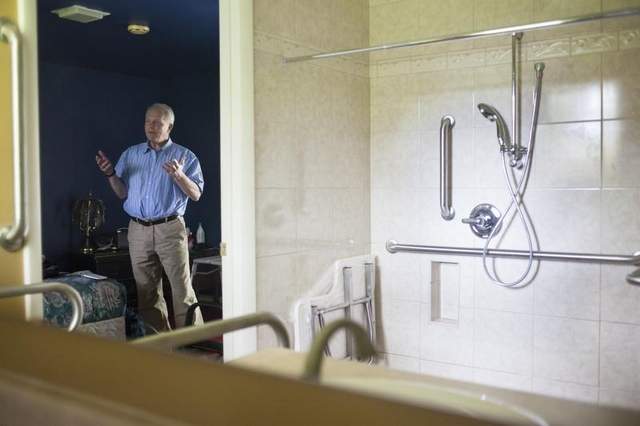|
More Residents are Opting for
Aging-in-Place
By
Matthew Daneman, DemocratandChronicle.com
May 17, 2012

Michael Millner of
Metro Legacy Homes explains the changes made
in a bathroom recently renovated for
wheelchair accessibility. Features include
grab bars, a seat in the shower and faucets
that are easier to operate. Aging baby boomers
represent a big potential home building and
home renovation market. LINDSEY LEGER
The
line between where the shower stall ends and
the rest of the bathroom begins is subtle,
just a gradual slope guiding water to a
drain in the shower stall floor. The
bathroom is Texas big — a 36-inch wide
doorway and enough space in the middle of
the floor for a wheelchair to easily do a
180.
Tasteful brushed metal grab bars
are affixed to the walls by the shower stall
and around the toilet. And hidden inside the
walls are plenty of backing for easy
installation of more bars.
In something prosaic like a
bathroom, functionality often wins out over
aesthetics. But the ground-floor facilities
Ron and Carolyn Gruschow had built last year
for their son, who has a variety of severe
health problems, take huge pains to be
attractive while also vastly more accessible
than the average bathroom.
And as the Lima couple get up in
years, the bathroom might eventually become
theirs. “We figured down the road it’s big
enough for us when we get old,” Ron Gruschow
said.
America is getting older. Between
2000 and 2010, the block of population ages
55-64 grew by 50.3 percent, far faster than
any other age range, according to a
Brookings Institution study. The number of
Americans ages 65 and up is expected to more
than double from roughly 40 million today to
nearly 90 million by 2050.
Those graying baby boomers
represent a big potential home building and
home renovation market. An analysis earlier
this year by the Center for Housing Policy
said that while estimates vary, some studies
indicate that one in four older adults will
likely end up with a mobility limitation
that requires some kind of home
modification. Those could range from the
relatively cheap — such as handrails and
bathroom grab bars — to roll-in showers or
stair lifts that carry potential price tags
of thousands of dollars.
Meanwhile, according to the center,
the vast majority of older homeowners have
indicated they want to stay in their homes
for as long as possible.
“Aging in place” — construction or
design features in a home that accommodate
older residents — represents a still new and
emerging field, said Michael Millner of
Brighton home contractor Metro Legacy Homes
LLC as he stood in a Pittsford bathroom
renovated earlier this year with a wider
doorway, a roll-in shower stall and space
beneath the cabinet, all to accommodate a
wheelchair.
The National Association of Home
Builders started its Certified Aging in
Place Specialist certification program for
contractors with specialized training in the
field in 2002. To date, there have been more
than 4,000 graduates, according to the
association. And 11 different firms
belonging to the Rochester Home Builders’
Association have CAPS-certified staffers.
Done right, aging-in-place features
are part of a universal design of a space
that makes it usable by anybody, able bodied
or not, Millner said.
The cost of incorporating design
into a project such as a renovation can add
as little as 5 percent to the cost, he said.
“There’s more thought that goes into it”
than a standard remodeling job, Millner
said.
But the fact America is aging
doesn’t automatically translate into a
populace willing to accept and embrace that
fact.
“Everybody is in denial,” said
Peter Rees of Rees & Co. Inc., a
Scottsville firm that specializes in
bathroom and kitchen work and which built
the Gruschow bathroom after, two years
earlier, renovating an upstairs bathroom to
be more accessible.
Less than 10 percent of his work
involves aging-in-place projects. “I don’t
think you could make a living just doing
accessible bathrooms,” Rees said.
“A part of the problem is the
concept needs to be more out there,” Millner
said “There are alternatives to putting
grandma in a home.”
Millner said universal design
projects represents perhaps 25 percent of
Metro Legacy’s business, though it is
growing.
The Gruschow bathroom was part of
an addition built on their Livingston County
house in 2011 to accommodate son Dylan,
giving him a ground-floor bathroom and
bedroom as going up and down the stairs
could be tremendously draining.
“I love it,” 20-year-old Dylan
said. “It doesn’t take as much energy to get
in, get a shower, and get out.”
“You’re not just trying to provide
what someone needs,” Rees said. “You’re
trying to give them something they like to
be in.”
|



